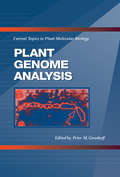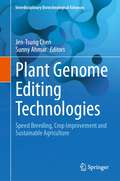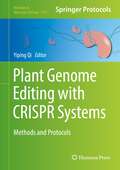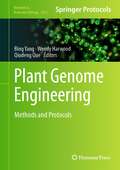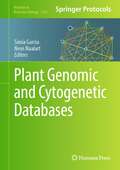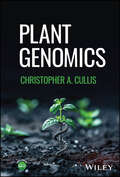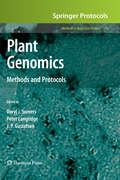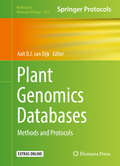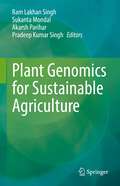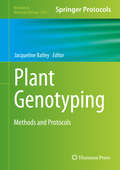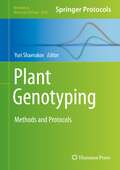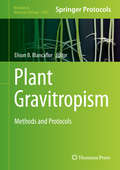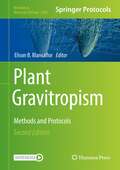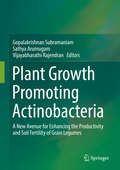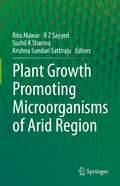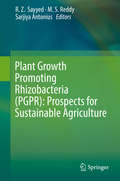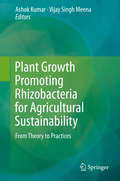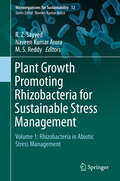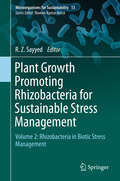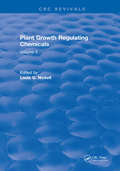- Table View
- List View
Plant Genome Analysis: Current Topics in Plant Molecular Biology (Current Topics In Plant Molecular Biology Ser.)
by Peter M. GresshoffPlant Genome Analysis presents outstanding analyses of technologies, as well as explanations of molecular technology as it pertains to agriculture. Advances in genome analysis, including DNA amplification (DAF and RAPD) markers, RFLPs, and microsatellites are reviewed by accomplished scientists, many of whom are the developers of the technique. Articles by patent lawyers experienced in plant biotechnology present the legal viewpoint.Chapters focus on special elements of genome analysis, such as the:use of antisense technologyinvestigation of telomeresproduction of plant YACsimportance of cell cycle genes in plants. Other chapters focus on specialized topics of genome analysis. These include a description of antisense technology in the study of photosynthesis and a comprehensive review of the characterization and isolation of plant telomere, including their use in varietal discrimination. A detailed anaysis of cytoplasmic male sterility in the french bean that focuses on the mitochondrial genome is described. The book provides a chapter on the production of yeast artificial chromosomes (YACs) carrying soybean DNA. Genes of the cell cycle in plants and their importance in developmental processes are presented, as well as detailed chapters on the molecular mapping of trees (apples and pines), and nodulation-related genes in legumes. A comprehensive index and a complete glossary are included.
Plant Genome Diversity Volume 1
by Johann Greilhuber Jonathan Wendel Ilia J. Leitch Jaroslav DolezelIn this timely new 2-volume treatise, experts from around the world have banded together to produce a first-of-its-kind synopsis of the exciting and fast moving field of plant evolutionary genomics. In Volume I of Plant Genome Diversity, an update is provided on what we have learned from plant genome sequencing projects. This is followed by more focused chapters on the various genomic "residents" of plant genomes, including transposable elements, centromeres, small RNAs, and the evolutionary dynamics of genes and non-coding sequences. Attention is drawn to advances in our understanding of plant mitochondrial and plastid genomes, as well as the significance of duplication in genic evolution and the non-independent evolution among sequences in plant genomes. Finally, Volume I provides an introduction to the vibrant new frontier of plant epigenomics, describing the current state of our knowledge and the evolutionary implications of the epigenomic landscape.
Plant Genome Editing Technologies: Speed Breeding, Crop Improvement and Sustainable Agriculture (Interdisciplinary Biotechnological Advances)
by Jen-Tsung Chen Sunny AhmarThis book reviews all important aspects of plant genome editing to shed new light on these genome editing technologies together in crop improvement and sustainable agriculture. The book is divided into three areas: the first of which reinterprets plant genome studies from an overview perspective, examining the safety and risk assessment of plants as well as breeding-related outcomes. The second area discusses recent advances in the understanding of crop improvement. A wide range of plant stress tolerance in relation to plant genome editing is then addressed, before turning attention to specific species approaches including rice, maize, wheat, and soybean. The entire book is devoted to an updated knowledge of plant genome editing technologies from all aspects of plant biology and agronomy as we move toward advancements in sustainable life research. The book will be highly recommended for agriculture biologists, agronomists, plant pathologists, and all related research areas.
Plant Genome Editing with CRISPR Systems: Methods and Protocols (Methods in Molecular Biology #1917)
by Yiping QiThis volume provides readers with wide-ranging coverage of CRISPR systems and their applications in various plant species. The chapters in this book discuss topics such as plant DNA repair and genome editing; analysis of CRISPR-induced mutations; multiplexed CRISPR/Cas9 systems; CRISPR-Cas12a (Cpf1) editing systems; and non-agrobacterium based CRISPR delivery systems. Written in the highly successful Methods in Molecular Biology series format, chapters include introductions to their respective topics, lists of the necessary materials and reagents, step-by-step, readily reproducible laboratory protocols, and tips on troubleshooting and avoiding known pitfalls.Comprehensive and thorough, Plant Genome Editing with CRISPR Systems: Methods and Protocols is a valuable resource for any researcher interested in learning about and using CRISPR systems in plants.
Plant Genome Engineering: Methods and Protocols (Methods in Molecular Biology #2653)
by Bing Yang Wendy Harwood Qiudeng QueThis volume provides readers with a collection of the latest protocols used to study plant genome editing and trait engineering. The chapters in this book are organized into five parts: genome engineering systems; machinery design and validation; delivery tools; generation and analysis of engineering materials; and crop genome engineering applications. The chapters cover topics such as methods of applying the popular CRISPR-Cas9 or CRISPR-Cas12 systems for editing genomes in different crop species, the use of small synthetic plastome for potato genome engineering, and the use of CRISPR-Cas9 for algal cell genome engineering. Written in the highly successful Methods in Molecular Biology series format, chapters include introductions to their respective topics, lists of the necessary materials and reagents, step-by-step, readily reproducible laboratory protocols, and tips on troubleshooting and avoiding known pitfalls.Cutting-edge and comprehensive, Plant Genome Engineering: Methods and Protocols is a valuable tool for researchers interested in learning more about this developing and important field.
Plant Genomic and Cytogenetic Databases (Methods in Molecular Biology #2703)
by Sònia Garcia Neus NualartThis volume discusses the latest online plant genomics and cytogenetic resources used by plant evolutionary biologists and plant breeders. The chapters in this book are organized into two parts. Part One looks at plant genomic databases, and covers topics such as plant phenomics and genomics research data repositories, InpactorDB, PlanTEenrichment, and PEATmoss, among others. Part Two looks at cytogenetics and chromosome-related databases, and covers resources such as the Plant DNA C-values database, the Delphineae Chromosome Database (DCDB), B-chrom, a Database on B-chromosomes, and the Plant Ribosomal DNA Database. Written in the highly successful Methods in Molecular Biology series format, chapters include introductions to their respective databases and offers explicit directions on how to access and get the most of these resources. Cutting-edge and comprehensive, Plant Genomic and Cytogenetic Databases is a valuable instrument for any plant science researcher who is interested in learning more about the wealth of information that is available through the use of these databases.
Plant Genomics
by Christopher A. CullisIntroduction to the range of molecular techniques to investigate unique facets of plant growth, development, and responses to the environment Plant Genomics introduces the complex relationship between the genome, microbiome, genes, and epigenetics of plants, as well as the range of molecular techniques applicable to investigating the unique facets of plant growth, development, and response to the environment. State-of-the-art science in the field is discussed, as well as future outlooks on what the next decade is likely to bring. This book includes new techniques for modifying the plant genome and their impact on modifying plants to combat the impact of biotic and abiotic stresses, including those associated with climate change, new technologies including long and short read sequencing and proximity ligation and the combination of these technologies for assembling sequence data into chromosomes, a new chapter on the sequences of the chloroplast and mitochondrial genomes, and a dedicated chapter to epigenetics and the importance in gene regulation. Written by a highly qualified author with significant published research contributions to the field, Plant Genomics includes information on: Structure and information content of the chloroplast and mitochondrial genomes and their use in phylogenyUse of transcriptomes from various tissues to identify expressed sequences and their identification as genesFunction of small regulatory RNAs and long non-coding RNAs and involvement of small RNAs in the control of gene expressionEpigenetic silencing of transposable elements and their release by stress and cross-generational contribution of epigenetic variation Use of the pan-genome to assemble a comprehensive germplasm for a particular crop species Plant Genomics is an ideal textbook for undergraduate courses on plant biology, particularly those focusing on molecular descriptions, and a helpful auxiliary text to plant biology laboratory courses. It will also be of interest to students in plant molecular biology, agricultural and food sciences, and plant, food, and crop bioengineering.
Plant Genomics
by J. P. Gustafson Peter Langridge Daryl J. SomersPlant genomics is a growing and constantly evolving field of study, one which has gained much ground in past years through the development of advanced research and data management tools. In Plant Genomics: Methods and Protocols, expert researchers explore the current issues and methodologies of this expanding field, specifically addressing areas of gene discovery and the functional analysis of genes with a focus on the primary tools and sub-disciplines of genetic mapping, mRNA, protein and metabolite profiling. Chapters employ exciting new methods to investigate molecular plant breeding technology and gene functional analysis via transformation, mutation, protein function, and gene expression. Composed in the highly successful Methods in Molecular Biology series format, each chapter contains a brief introduction, step-by-step methods, a list of necessary materials, and a Notes section which shares tips on troubleshooting and avoiding known pitfalls. Comprehensive and innovative, Plant Genomics: Methods and Protocols is an essential guide for all plant scientists who are interested in further studies in the area of genomics research.
Plant Genomics Databases
by Aalt D.J van DijkThis volume introduces databases containing the results from the recent revolution in sequencing technologies. Chapters in Plant Genomics Databases: Methods and Protocols describe database content, as well as typical use-cases. Some chapters explore databases that primarily present genome sequences focusing on one or a few related species, while others include additional datatypes and/or data from various plant species. Written in the highly successful Methods in Molecular Biology series format, chapters include introductions to their respective topics, step-by-step, readily reproducible protocols, and tips on troubleshooting and avoiding known pitfalls.Cutting-edge and comprehensive, Plant Genomics Databases: Methods and Protocols is a valuable resource for providing clear guidance in accessing an important collection of plant databases that can be used to add biological value to genomic data.
Plant Genomics for Sustainable Agriculture
by Ram Lakhan Singh Pradeep Kumar Singh Sukanta Mondal Akarsh PariharThis book collates the basic and advanced concepts of plant biotechnology and genomics along with the future trends. It discusses the combination of conventional breeding techniques with genomic tools and approaches leading to a new genomics-based plant breeding technology supporting crop plants that respond better to biotic and abiotic stress, and pathogen attacks. Plant genomics play an important role in developing more efficient plant cultivars which are essential for the neo green revolution needed to feed the world’s rapidly growing population. Plant genomic data is being utilized in genetic engineering to ensure that better and resilient varieties of crops are available ensuring food security. This book is of immense interest to teachers, researchers, crop scientists, capacity builders, and policy makers. Also, the book serves as additional reading material for undergraduate and graduate students of agriculture, biotechnology, genomics, soil science, and environmental sciences. National and International agricultural scientists and policy makers will also find this to be a useful read.
Plant Genotyping
by Jacqueline BatleyThe ability to produce vast amounts of DNA sequence data has enabled the discovery of molecular markers in model organisms, crops, as well as orphan species making genotyping the rate limiting factor, and this volume focuses on the different markers available and the low to high throughput genotyping of these markers. Given the diverse nature of some of these systems, an overview is provided on the identification of markers from sequence data, as well as data analysis with example applications once the genotyping data has been generated. Written in the successful Methods in Molecular Biology series format, chapters include introductions to their respective topics, lists of the necessary materials and reagents, step-by-step, readily reproducible protocols, and notes on troubleshooting and avoiding known pitfalls. Authoritative and easily accessible, Plant Genotyping: Methods and Protocols is aimed at plant molecular biologists, geneticists, plant breeders and ecologists who have a target question and need to know the most suitable markers and genotyping system to use.
Plant Genotyping: Methods and Protocols (Methods in Molecular Biology #2638)
by Yuri ShavrukovThis thorough volume presents a wide range of existing methods, from the very popular to the more exotic, in the area of plant genotyping. Many methods of plant genotyping were initially developed for medical research, but all genotyping methods, if they are to be successful, should be suitable for application across the full range of studies within plant biology, as seen in this collection. Plant genotyping methods herein are based on a variety of assessments, including DNA microarray, with its hundreds of thousands of simultaneous reactions, or separate individual studies of DNA sequencing and fragment analysis, PCR and qPCR, allele-specific molecular probes and primers, digestion with restriction endonucleases, microscopy and many others. Written for the highly successful Methods in Molecular Biology series, chapters include introductions to their respective topics, lists of the necessary materials and reagents, step-by-step and readily reproducible laboratory protocols, and tips on troubleshooting and avoiding known pitfalls. Authoritative and practical, Plant Genotyping: Methods and Protocols offers researchers the opportunity to update their knowledge and choose the most suitable method of plant genotyping for their chosen application.
Plant Geography (Routledge Revivals)
by Martin KellmanOriginally published in 1975 and in a second edition in 1980, Plant Geography was the first text in biogeography that provided an adequate treatment of modern plant population theory. It is an introduction to the subject for students of both geography and biology. The author develops a series of plant geographic concepts that are based primarily in plant population biology, treating in turn processes that operate at the level of the individual plant and the plant population; interactions between plant populations; environmental conditions and plant dissemination in shaping plant species’ distributions, and the geography of vegetation. Emphasis throughout is placed upon the dynamic nature of the earth’s plant cover, and the interplay between contemporary conditions and historical events in shaping plant distributions and evolution.
Plant Geography of Chile
by Andres Moreira-MunozThe first and so far only Plant Geography of Chile was written about 100 years ago, since when many things have changed: plants have been renamed and reclassified; taxonomy and systematics have experienced deep changes as have biology, geography, and biogeography. The time is therefore ripe for a new look at Chile's plants and their distribution. Focusing on three key issues - botany/systematics, geography and biogeographical analysis - this book presents a thoroughly updated synthesis both of Chilean plant geography and of the different approaches to studying it. Because of its range - from the neotropics to the temperate sub-Antarctic - Chile's flora provides a critical insight into evolutionary patterns, particularly in relation to the distribution along the latitudinal profiles and the global geographical relationships of the country's genera. The consequences of these relations for the evolution of the Chilean Flora are discussed. This book will provide a valuable resource for both graduate students and researchers in botany, plant taxonomy and systematics, biogeography, evolutionary biology and plant conservation.
Plant Gravitropism
by Elison B. BlancaflorThis volume provides the plant scientific community with a collection of established and recently developed experimental protocols to study plant gravitropism. The first few chapters in this book discuss topics such as methods to properly orient plant material for gravitropism studies; protocols for data collection and image analysis; and techniques to investigate ion, organelle, and auxin transporter dynamics, particularly in living cells, as the plant is responding to a change in its orientation. The next few chapters talk about topics that are essential for understanding the complexities underlying tropisms and plant movements in general, and outline basic protocols on handling ornamental flowering shoots for basic plant gravitropism studies. The book concludes with chapters that discuss plant biological studies in space in order to take advantage of unique microgravity conditions not available in Earth-based studies. Written in the highly successful Methods in Molecular Biology series format, chapters include introductions to their respective topics, lists of the necessary materials and reagents, step-by-step, readily reproducible laboratory protocols, and tips on troubleshooting and avoiding known pitfalls. Informative and cutting-edge, Plant Gravitropism is the perfect book for researchers in the plant scientific community because it is not only useful for plant gravitropism studies, but also addresses a range of interesting problems in plant growth and development.
Plant Gravitropism: Methods and Protocols (Methods in Molecular Biology #2368)
by Elison B. BlancaflorThis updated and expanded edition explores key methodologies to study the fascinating phenomenon of how plants readjust their growth toward gravity. In addition to the protocols delivering broad applications for gaining insight into other plant physiological processes, this new volume also focuses on techniques involving plants in space or the use of microgravity analogs to study plant biological phenomenon. Written for the highly successful Methods in Molecular Biology series, chapters include introductions to their respective topics, lists of the necessary materials and reagents, step-by-step, readily reproducible laboratory protocols, and tips on troubleshooting and avoiding known pitfalls. Authoritative and cutting-edge, Plant Gravitropism: Methods and Protocols, Second Edition serves as an ideal guide for researchers studying the cellular, molecular, and biochemical networks that plants use to translate environmental stimuli into a growth response.
Plant Growth Promoting Actinobacteria
by Gopalakrishnan Subramaniam Sathya Arumugam Vijayabharathi RajendranGlobal yields of legumes have been relativelystagnant for the last five decades, despite the adoption of conventional andmolecular breeding approaches. The use of plant growth-promoting (PGP) bacteriafor improving agricultural production, soil and plant health has become one ofthe most attractive strategies for developing sustainable agriculture. Actinomycetes arebacteria that play an important role in PGP and plant protection, producesecondary metabolites of commercial interest, and their use is well documented inwheat, rice, beans, chickpeas and peas. In order to promote legumes, the general assembly ofthe UN recently declared 2016 the "International Year of Pulses. " In view ofthis development, this book illustrates how PGP actinomycetes can improve grainyield and soil fertility, improve control of insect pests and phytopathogens,and enhance host-plant resistance. It also addresses special topics of currentinterest, e. g. the role of PGP actinomycetes in the biofortification of legumeseeds and bioremediation of heavy metals.
Plant Growth Promoting Microorganisms of Arid Region
by Ritu Mawar R Z Sayyed Sushil K Sharma Krishna Sundari SattirajuThis edited book aims to focus on microbial diversity in arid lands and deserts versus specific microbial assemblages associated with plants. The book explains ecological drivers that shape this diversity, how plant-associated microbiomes are selected, and their biotechnological potential are discussed. Diversity and functional redundancy of these associated PGPM make them very active in supporting plant improvement, health and resistance to drought, salt and other stresses, and these dimensions will be explored in this book. Implementing proper biotechnological applications of the arid and desert-adapted PGPM constitutes a sizeable challenge, and the book attempts to take up that challenge and help researchers in this field to gain a detailed understanding of PGPM from arid ecosystems. This book serves as a handbook for research workers, teachers, postgraduate students and extension personnel, other development workers, and policy planners engaged in arid zone development.
Plant Growth Promoting Rhizobacteria (PGPR): Prospects for Sustainable Agriculture
by M. S. Reddy R. Z. Sayyed Sarjiya AntoniusSustainable increase in agricultural production while keeping the environmental quality, agro-ecosystem function and biodiversity is a real challenge in current agricultural practices. Application of PGPR can help in meeting the expected demand for increasing agricultural productivity to feed the world’s booming population. Global concern over the demerits of chemicals in agriculture has diverted the attention of researchers towards sustainable agriculture by utilizing the potential of Plant Growth Promoting Rhizobacteria (PGPR). Use of PGPR as biofertilizers, biopesticides, soil, and plant health managers has gained considerable agricultural and commercial significance. The book Plant Growth Promoting Rhizobacteria (PGPR): Prospects for Sustainable Agriculture has contributions in the form of book chapter from 25 eminent global researchers, that discusses about the PGPRs and their role in growth promotion of various crop plants, suppression of wide range of phytopathogens, their formulation, effect of various factors on growth and performance of PGPR, assessment of diversity of PGPR through microsatellites and role of PGPR in mitigating biotic and abiotic stress.This book will be helpful for students, teachers, researchers, and entrepreneurs involved in PGPR and allied fields. The book will be highly useful to researchers, teachers, students, entrepreneurs, and policymakers.
Plant Growth Promoting Rhizobacteria for Agricultural Sustainability: From Theory to Practices
by Ashok Kumar Vijay Singh MeenaTo meet the food security needs of the 21st century, this book focuses on ecofriendly and sustainable production technologies based on plant growth promoting rhizobacteria (PGPR). It is estimated that the global population could increase to 9 billion by 2050. Further, the amount of land devoted to farming has decreased. Soil is a living entity, and is not only a valuable natural resource for agricultural and food security, but also for the preservation of all life processes. Agricultural productivity rests on the foundation of microbial diversity in the soil, and in recent years, PGPR have emerged as an important and promising tool for sustainable agriculture.The injudicious use of agrochemicals by farmers has created a range of negative impacts, not only threatening the environment, but also destroying useful microorganisms in the soil. The efficient use of PGPR reduces the need for these chemicals while simultaneously lowering production costs. In turn, increased yields could provide a more favourable environment and encourage sustainability. This book assesses the impacts of PGPR on crops, environmental and socio-economic sustainability, and demonstrates these ecofriendly technologies’ three critical advantages, namely (a) enhanced crop productivity, (b) reduced application of agrochemicals, and (c) increased incomes for farmers. Besides offering an economically attractive and ecologically sound means of augmenting the nutrient supply and combatting soil-borne pathogens, PGPR play an important part in boosting soil fertility, bioremediation and stress management for the development of ecofriendly and sustainable agriculture.
Plant Growth Promoting Rhizobacteria for Horticultural Crop Protection
by P. Parvatha ReddyThe use of synthetic pesticides has undoubtedly resulted in the achievement of increased crop production. However, in recent times, there has been a considerable pressure on consumers and farmers to reduce or eliminate the use of synthetic pesticides in horticulture, since fruits and vegetables are consumed afresh. This concern has encouraged looking for better alternatives which are cheaper and eco-friendly than synthetic pesticides. It is well known that plant growth promoting rhizobacteria (PGPR) play an important role in maintaining crop and soil health through versatile mechanisms. There are two main outcomes or effects from beneficial microorganisms: enhanced plant growth and crop protection, both of which represent the two main constraints to agriculture. The information on biomanagement of pests (insect and nematode pests, fungal, bacterial and viral/phytoplasma diseases) of horticultural crops (fruits, vegetables, plantation, spice, tuber, ornamental, medicinal and aromatic crops) using PGPR is very much scattered. There is no book at present which comprehensively and exclusively deals with the above aspects on horticultural crops. The present book deals with biomanagement of pests in horticultural crops in detail using PGPR. The present book deals with biomanagement of pests in horticultural crops in detail using PGPR. The present book is divided into six sections. The first section deals with the importance of PGPR including introduction, potential role of PGPR in agriculture, genera of PGPR, disease management, nematode management, insect pest management, integrated pest management, mechanism of biocontrol, mass production, formulation, delivery and commercialization. Pest management in tropical, sub-tropical and temperate fruit crops is dealt in Section II. The third section deals with pest management in Solanaceous, bulbous, Malvaceous, Cruciferous, Leguminous, Cucurbitaceous, leafy and root and tuber vegetable crops. Pest management in plantation and spice crops is in Section IV. Section V deals with pest management in ornamental, medicinal and aromatic crops. The last section deals with a road map ahead including challenges, future prospective and conclusions. The book is extensively illustrated with excellent quality photographs enhancing the quality of publication. The book is written in lucid style, easy to understand language along with adoptable recommendations involving eco-friendly components of IPM.
Plant Growth Promoting Rhizobacteria for Sustainable Stress Management: Volume 1: Rhizobacteria in Abiotic Stress Management (Microorganisms for Sustainability #12)
by Naveen Kumar Arora M. S. Reddy R. Z. SayyedIncreasing agro productivity to feed a growing global population under the present climate scenario requires optimizing the use of resources and adopting sustainable agricultural production. This can be achieved by using plant beneficial bacteria, i.e., those bacteria that enhance plant growth under abiotic stress conditions, and more specifically, microorganisms such as plant growth promoting rhizobacteria (PGPR), which are the most promising candidates in this regard. Attaining sustainable agricultural production while preserving environmental quality, agro-ecosystem functions and biodiversity represents a major challenge for current agricultural practices; further, the traditional use of chemical inputs (fertilizers, pesticides, nutrients etc.) poses serious threats to crop productivity, soil fertility and the nutritional value of farm produce. Given these risks, managing pests and diseases, maintaining agro-ecosystem health, and avoiding health issues for humans and animals have now become key priorities. The use of PGPR as biofertilizers, plant growth promoters, biopesticides, and soil and plant health managers has attracted considerable attention among researchers, agriculturists, farmers, policymakers and consumers alike. Using PGPR can help meet the expected demand for global agricultural productivity to feed the world’s booming population, which is predicted to reach roughly 9 billion by 2050. However, to do so, PGPR strains must be safe for the environment, offer considerable plant growth promotion and biocontrol potential, be compatible with useful soil rhizobacteria, and be able to withstand various biotic and abiotic stresses. Accordingly, the book also highlights the need for better strains of PGPR to complement increasing agro-productivity.
Plant Growth Promoting Rhizobacteria for Sustainable Stress Management: Volume 2: Rhizobacteria in Biotic Stress Management (Microorganisms for Sustainability #13)
by R. Z. SayyedAttaining sustainable agricultural production while preserving environmental quality, agro-ecosystem functions and biodiversity represents a major challenge for current agricultural practices; further, the traditional use of chemical inputs (fertilizers, pesticides, nutrients etc.) poses serious threats to crop productivity, soil fertility and the nutritional value of farm produce. Given these risks, managing pests and diseases, maintaining agro-ecosystem health, and avoiding health issues for humans and animals have now become key priorities. The use of PGPR as biofertilizers, plant growth promoters, biopesticides, and soil and plant health managers has attracted considerable attention among researchers, agriculturists, farmers, policymakers and consumers alike. Using PGPR as bioinoculants can help meet the expected demand for global agricultural productivity to feed the world’s booming population, which is predicted to reach roughly 9 billion by 2050. However, to provide effective bioinoculants, PGPR strains must be safe for the environment, offer considerable plant growth promotion and biocontrol potential, be compatible with useful soil rhizobacteria, and be able to withstand various biotic and abiotic stresses. Accordingly, the book also highlights the need for better strains of PGPR to complement increasing agro-productivity.
Plant Growth Regulating Chemicals: Volume I
by Louis G. NickellThe purpose of this two-volume work is to make available both to the investigator and user, on a crop by crop basis, the latest information on the use of chemicals to regulate plant growth and development. Emphasis is given to the major crops and to those which the most success has been achieved.
Plant Growth Regulating Chemicals: Volume II
by Louis G. NickellThe purpose of this two-volume work is to make available both to the investigator and user, on a crop by crop basis, the latest information on the use of chemicals to regulate plant growth and development. Emphasis is given to the major crops and to those which the most success has been achieved.
